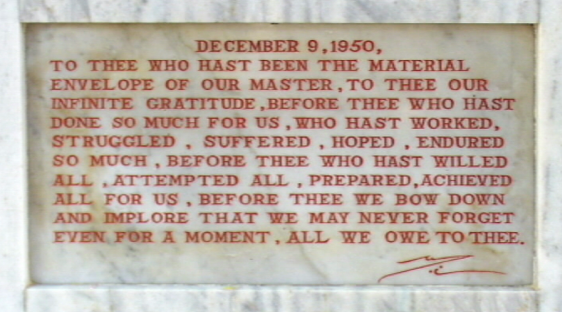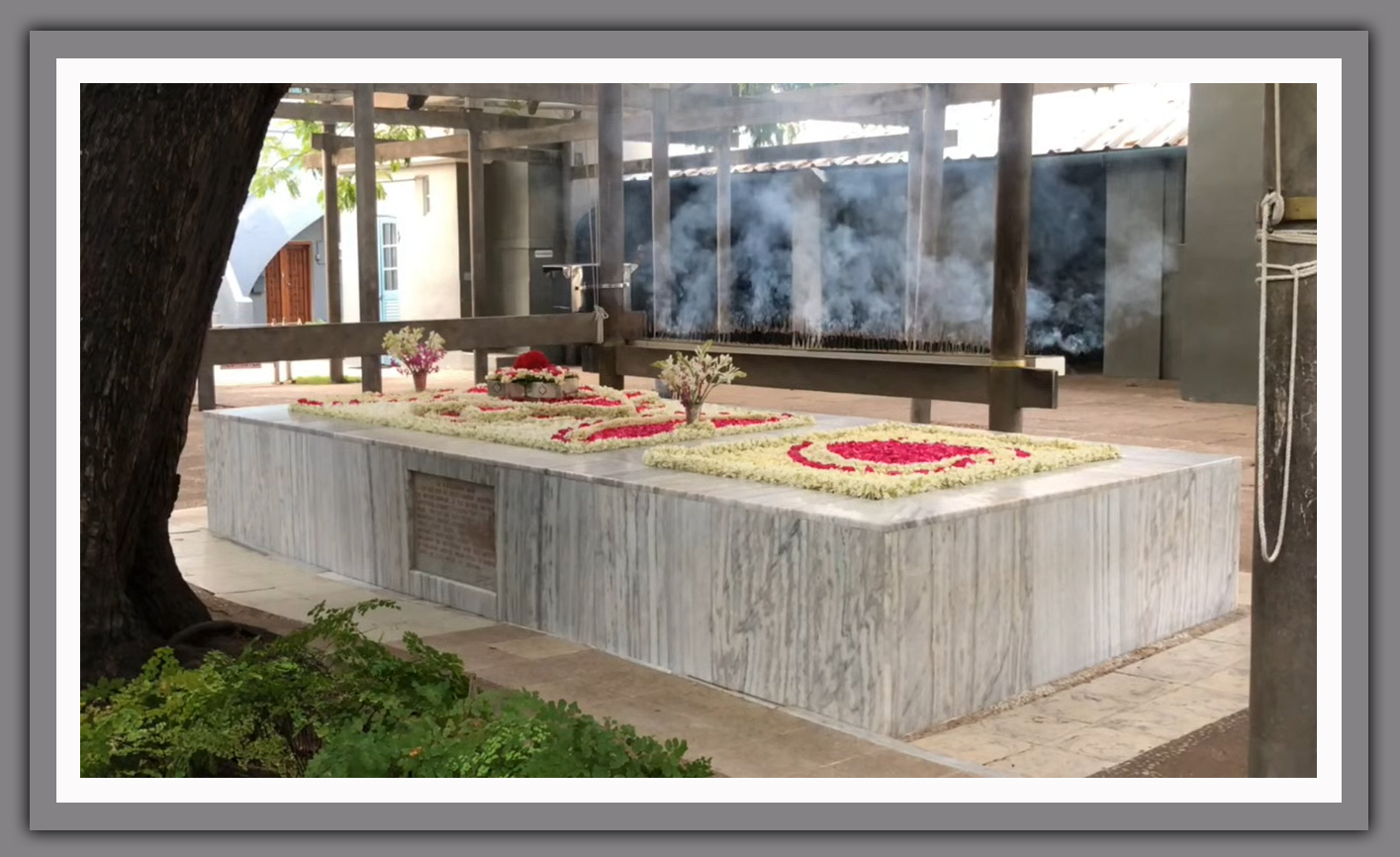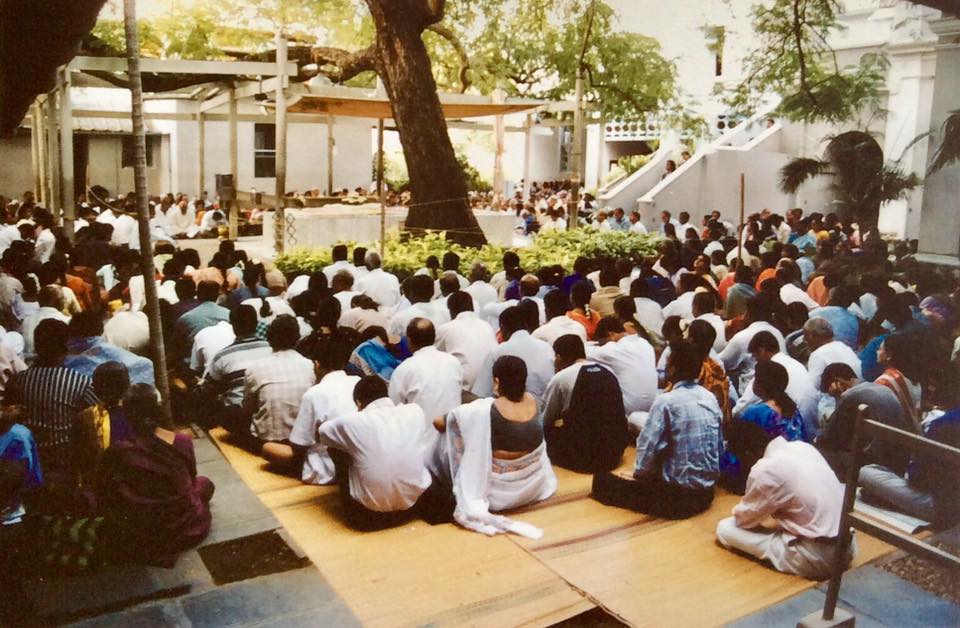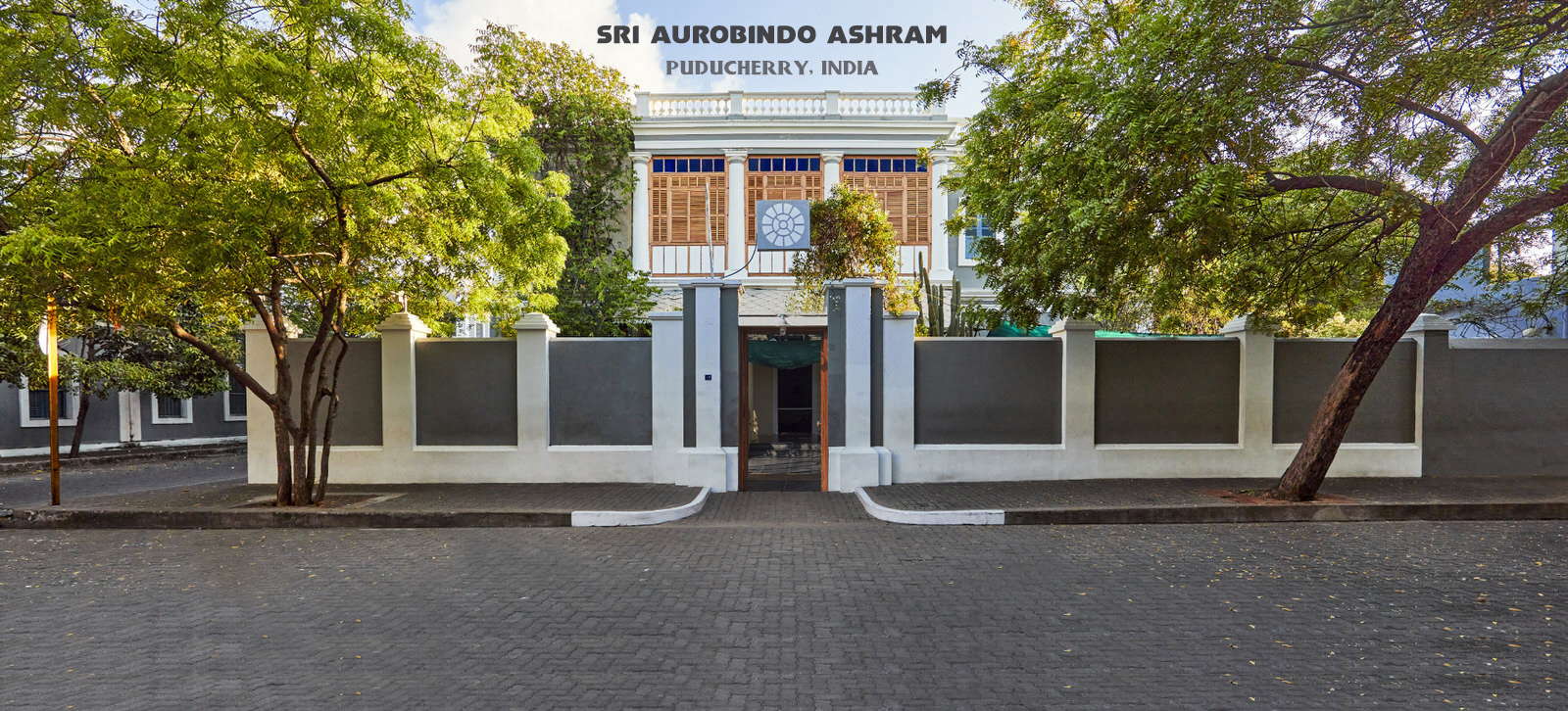

This Ashram has been created with another object than that ordinarily common to such institution, not for the renunciation of the world but as a centre and a field of practice for the evolution of another kind and form of life which would in the final end be moved by a higher spiritual consciousness and embody a greater life of the spirit.
Sri Aurobindo
Founded in 1926, the Sri Aurobindo Ashram has grown, under the Mother's guidance, from a small group of two dozen disciple into a large diversified community with around 1500 members. including the students of Sri Aurobindo International Centre of Education and the devotees who live nearby, the community as a whole consists of several thousands.
Situated in a bustling city of 1100, 000 people, the Ashram is not a quite place of retreat secluded from the world but a vibrant centre of life in a modern urban setting. The dynamic character of the community reflects the life-affirming aim of Sri Aurobindo's Yoga—the Integral Yoga. Work as an offering to the Divine is an essential aspect of the Yoga, Ashramities do some useful work every day in the various departments.
In the sadhana or spiritual discipline at the Ashram, there are no obligatory practice, no rituals, no compulsory meditations or systematic instruction in Yoga. Each sadhak is left free to determine the course and pace of his sadhana in accordance with the same for all: there must be a surrender to the Divine and an opening to the Divine Force so that it may work to transform one's being.
The Ashram is located in the eastern part of Puducherry. Ashramites live and work in a large number of building spread throughout the area. The focus of community life is the Ashram main building, usually called simply "the Ashram", which consists of an interconnected block of houses, including those in which Sri Aurobindo and the Mother dwelt for most of their lives. at its centre in a tree-shaded courtyard lies the Samadhi, a white-marble shrine where their bodies are laid to rest.


The Ashram provides its members with all they need for a decent and healthy life. Various departments have been organised to look after the basic requirements of food, clothing and shelter, as well as medical care. the Ashram has its own farms and gardens. There are also libraries for study and facilities for a variety of cultural pursuits. The ashram is administered by the Sri Aurobindo Ashram Trust.
Sri Aurobindo on the Ashram — A Laboratory
It is necessary or rather inevitable that in an Ashram which is a "laboratory", as X puts it, for a spiritual and supramental yoga, humanity should be variously represented. For the problem of transformation has to deal with all sorts of elements favourable and unfavourable. The same man indeed carries in him a mixture of these two things. If only sattwic and cultured men come for yoga, men without very much of the vital difficulty in them, then, because the difficulty of the vital element in terrestrial nature has not been faced and overcome, it might well be that the endeavour would fail. There might conceivably be under certain circumstances an overmental layer super imposed on the mental, vital and physical, and influencing them, but hardly anything supramental or a sovereign transmutation of the human being. Those in the Ashram come from all quarters and are of all kinds; it cannot be otherwise.
In the course of the yoga, collectively though not for each one necessarily—as each plane is dealt with, all its difficulties arise. That will explain much in the Ashram that people do not expect there. When the preliminary work is over in the "laboratory", things must change.
Also, much stress has not been laid on human fellowship of the ordinary kind between the inmates (though good feeling, consideration and courtesy should always be there,) because that is not the aim; it is unity in a new consciousness that is the aim, and the first thing is for each to do his sadhana, to arrive at that new consciousness and realise oneness there.
Whatever faults are there in the sadhaks must be removed by the Light from above—a sattwic rule can only change nature's predisposed to a sattwic rule.
SABCL 23:856-7
The Mother on the Ashram
The Ashram is a condensation of dynamic and active peace, so much so that all those who come from outside feel as if they were in another world. It is indeed something of another world, a world in which the inner life governs the outer, a world where things get done, where work is carried out not for a personal end but in a selfless way for the realisation of an ideal. The life we lead here is as far from ascetic abstinence as from an enervating comfort; simplicity is the rule here, but a simplicity full of variety—a variety of occupations, of activities, of tastes, tendencies, natures; each one is free to organise his life as he pleases, the discipline is reduced to the minimum that is indispensable to organise the existence...of people and to avoid movements that would be detrimental to the achievement of our yogic aim.
CWM 16:7-8

Sri Aurobindo Ashram
Visiting Hours: Ashram Gate Open Time (Reference: Ashram Notice Board)
Morning : 5.30 am to 8 am for Ashramites and Pass Holders
8 am to 11.30 am for General Visitors
Afternoon:2 pm to 6 pm for General Visitors
6 pm to 10 pm for Ashramites and Pass Holders.
| SPECIAL DAYS IN THE ASHRAM | ||||
| 01 | January | New Year Meditation | Collective Meditation around the Samadhi — Timing 6 am to 6.30 am* | |
| 21 | February | The Mother's Birthday | 1878 | Darshan Day - Sri Aurobindo's and the Mother's Room Darshan - 4am to 6pm* |
| 29 | February | The Golden Day (Supramental Decent) | 1956 | Darshan Day - Sri Aurobindo's and the Mother's Room Darshan - 4am to 6pm* |
| 24 | April | The Mother's final arrival in Pondicherry | 1920 | Darshan Day - Sri Aurobindo's Room Darshan - 5 am to 12 noon* |
| 15 | August | Sri Aurobindo's Birthday | 1872 | Darshan Day - Sri Aurobindo's Room Darshan - 4 am to 6 pm* |
| 17 | November | The Mother's Mahasamadhi | 1973 | Darshan Day - The Mother's Room Darshan - 4 am to 12 noon* |
| 20 | November | The Mother's body laid to rest | 1973 | Collective Meditation around the Samadhi - Timing 6 am to 6.30 am* |
| 24 | November | Siddhi Day | 1926 | Darshan Day - Sri Aurobindo's Room Darshan - 5 am to 11 am* |
| 1-2 | December | Anniversary of the Ashram School SAICE | 1943 | 1st Dec Theatre programme and 2nd Dec Sports Ground programme |
| 05 | December | Sri Aurobindo's Mahasamadhi | 1950 | Darshan Day - Sri Aurobindo's Room Darshan - 5 am to 10 am* |
| 09 | December | Sri Aurobindo's body laid to rest | 1950 | Collective Meditation around the Samadhi - Timing 6 am to 6.30 am* |
| Note: * Please see the Ashram Notice Board one week before darshan days for the darshan timing and time entry token for 21st February, 29th February & 15th August Room Darshan. Also see the Ashram Notice Board for the School Anniversary programme timing. Darshan Day Collective Meditation around the Samadhi - Timing 6 am to 6.30 am. | ||||

![]()
Meditation
Collective Meditation around the Samadhi — Timing 7.30 pm to 7.50 pm on Mondays, Tuesdays, Wednesdays and Fridays
Collective Meditation in the Ashram Play Ground — Timing 7.45 pm to 8.15 pm on Thursdays and Sundays


